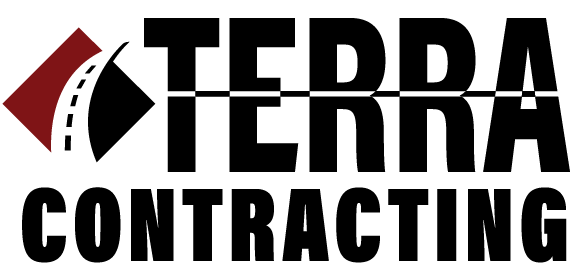After more than 30 years in the underground utility installation field, we know exactly what open trenching brings to a project: damaged pavement, disrupted businesses, and longer timelines than desired. HDD has become the solution when every day matters and tearing up pavement simply isn’t an option.
What Is Horizontal Directional Drilling?
Horizontal directional drilling is a trenchless method for installing underground utilities. Rather than digging along the entire route, HDD creates a guided borehole underground while leaving surface elements completely untouched.
Our crews at Terra Contracting use HDD to install everything from electrical conduits to fiber optic lines. We drill precise underground paths, avoiding existing utilities while maintaining consistent depth and alignment from entry to exit point. This gives us the flexibility to run utilities almost anywhere while minimizing pavement damage, protecting landscaping, and reducing traffic impact.
Key Benefits of HDD for Underground Construction
How HDD Minimizes Surface Disruption
Imagine needing to run telecom lines beneath a busy Las Vegas street. Traditional trenching means lane closures, pavement removal, and a line of frustrated business owners or commuters calling the city. With HDD, we set up small entry and exit points and drill beneath everything else. No torn-up surfaces, no business shutdowns or disgruntled commuters.
Safety and Environmental Advantages
HDD brings several built-in safety and environmental benefits:
Fewer open trenches means fewer jobsite hazards for our crews and the public. Landscaping and hardscape features stay preserved throughout the project. Less soil movement translates to lower erosion risk. Minimal restoration work keeps emissions and fuel consumption down compared to traditional methods.
Step-by-Step Overview of the HDD Process
Here’s how a typical directional drilling project gets done:
- Planning and Site Investigation: We review site conditions, analyze soil types, and map existing infrastructure to determine the safest drill path.
- Pilot Hole Drilling: Using advanced tracking tools, we drill a narrow pilot hole along the mapped route.
- Pullback Operation: We attach the utility line or conduit and pull it back through the prepared hole, using drilling fluid to keep everything clean and maintain stability.
- Testing and Completion: We verify alignment and performance before making final tie-ins.
Comparing HDD to Traditional Trenching Methods
The differences between horizontal directional drilling and traditional trenching are significant:
Traditional Trenching
- Full excavation needed along the entire utility path.
- Longer traffic disruption and lane closure timeframes.
- High restoration costs including pavement, landscaping, and concrete.
- More risk of erosion and soil disturbance.
- Slower timelines due to multi-phase work and cleanup.
Horizontal Directional Drilling
- Only the entry and exit points are disturbed; there’s no need to trench the entire route.
- Keeps roads open and businesses accessible.
- Lower surface restoration costs.
- Minimal impact to the environment.
- Faster project completion with fewer moving parts.
We’ve tracked these differences across dozens of projects. While HDD may appear to cost slightly more upfront, it typically saves money overall, especially when you consider surface restoration, traffic control expenses, and project delays.
Ideal Use Cases for Horizontal Directional Drilling
We recommend HDD when surface access is limited or disruption isn’t acceptable:
- Urban Areas: Complete installations without affecting roadways, business ingress and egress, or pedestrian traffic.
- Road Crossings: Run utilities beneath highways and busy intersections safely.
- Sensitive Sites: Avoid damage in landscaped areas or environmentally protected zones.
- Tight Corridors: Thread new utilities between existing lines without creating conflicts.
- Historic Zones: Upgrade infrastructure while preserving surface integrity and historical features.
Choosing the Right Horizontal Directional Drilling Contractor for Your Underground Utility Project
Directional drilling success depends on careful planning, skilled execution, and the ability to adapt when underground conditions change unexpectedly.
Here’s what to look for:
- Experience with similar jobs and soil types
- Reliable HDD rigs and up-to-date tracking gear
- A solid safety record on trenchless jobs
- A team that can adapt when the ground throws curveballs
At Terra Contracting, our directional drilling crews bring the tools, training, and field experience to handle complex installations throughout Nevada and the Southwest. Whether it’s conduit under a busy boulevard or fiber optic lines through a narrow easement, we complete the work with minimal surface disruption.
Let’s Talk About Your Next HDD Project
When your underground utility installation needs to move quickly while keeping the surface intact, HDD delivers the solution and Terra provides the expertise to make it happen. Contact us today to discuss your directional drilling needs.

